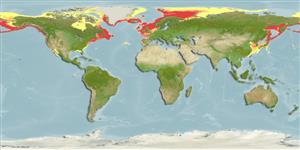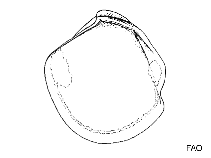Thyasira gouldii (Philippi, 1845)
| Native range | All suitable habitat | Point map | Year 2050 |

|
| This map was computer-generated and has not yet been reviewed. |
| Thyasira gouldii AquaMaps Data sources: GBIF OBIS |
Google image | No image available for this species;
drawing shows typical species in Thyasiridae.
Classification / Names Common names | Synonyms | CoL | ITIS | WoRMS
Bivalvia | Lucinida | Thyasiridae
Environment: milieu / climate zone / depth range / distribution range Ecology
Benthic; depth range 8 - 572 m (Ref. 83435). Polar; 83°N - 33°N, 142°E - 74°E
Distribution Countries | FAO areas | Ecosystems | Occurrences | Introductions
Pacific Ocean, Atlantic Ocean and the Arctic.
Length at first maturity / Size / Weight / Age
Maturity: Lm ? range ? - ? cm Max length : 0.6 cm DL male/unsexed; (Ref. 83435)
Life cycle and mating behavior Maturity | Reproduction | Spawning | Eggs | Fecundity | Larvae
Main reference
References | Coordinator | Collaborators
Cusson, M., P. Archambault and A. Aitken 2007 Biodiversity of benthic assemblages on the Arctic continental shelf: historical data form Canada. Mar. Ecol. Prog. Ser. 331:291-304. (Ref. 3448)
IUCN Red List Status
(Ref. 130435: Version 2025-1)
CITES status (Ref. 108899)
CMS (Ref. 116361)
Threat to humans
Human uses
| FishSource |
Tools
More information
Diet composition
Food consumption
Predators
Max. ages / sizes
Length-weight rel.
Length-length rel.
Length-frequencies
Mass conversion
Abundance
Internet sources
BHL | BOLD Systems | CISTI | DiscoverLife | FAO(Publication : search) | Fishipedia | GenBank (genome, nucleotide) | GloBI | Gomexsi | Google Books | Google Scholar | Google | PubMed | Tree of Life | Wikipedia (Go, Search) | Zoological Record



